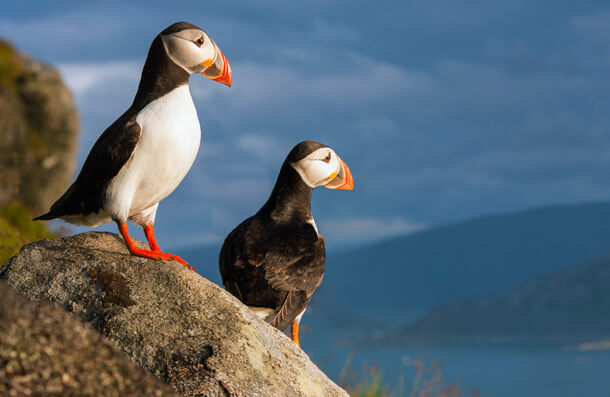Interactive Website Offers New Tool to Reduce Seabird Bycatch
Contact: David Wiedenfeld, 540-253-5780, dwiedenfeld@abcbirds.org

Atlantic Puffin is one of the seabird species that stands to benefit from the new interactive tool. Photo by Gertjan Hooijer/Shutterstock
(Washington, D.C., September 15, 2015) Hundreds of thousands of birds are accidentally injured or killed every year in fisheries around the world. A dynamic new website (www.fisheryandseabird.info) – created by American Bird Conservancy and The Pennsylvania State University's Center for Environmental Informatics – puts a wealth of information helpful in reducing this “bycatch” right at the fingertips of those who need it most: fishermen, conservationists, and those promoting fishery sustainability.
The site, explained in an introductory video, is designed to help users assess the risk for the accidental capture of seabirds in fisheries, and take action to reduce bycatch. Seabirds are among the most threatened groups of birds, with approximately 29 percent of seabird species listed in the International Union for Conservation of Nature (IUCN) Red List categories Critically Endangered, Endangered, and Vulnerable.
Featuring a database with profiles of 378 seabird species, the website offers a unique way to access a wealth of information. After drawing a map that outlines an area of interest, one click produces a list of seabirds known to occur there, along with useful information for assessing the risk posed to seabirds by fishing gear. Users can:
- Create fishery area maps and determine which birds occur there.
- Review protected status, population size, and range maps.
- Produce reports with information such as diving depth and diet that may indicate the risk posed by fishing gear.
- Find resources on how to reduce bycatch.
“This technology gives fishers the information they need to avoid bycatch they don't want and that can cause them problems,” said Dr. David Wiedenfeld, ABC's Senior Conservation Scientist and a lead architect of the site. “The tool substantially reduces research time for those evaluating a fishery or considering fishery improvements. The volume of information here used to take months to compile, but now it is all available in a matter of seconds. We hope this information can be used to reduce the number of seabirds being killed by commercial fishing.”
In the interactive map feature, users can overlay the base map with layers showing bird species ranges, as well as jurisdictions such as Exclusive Economic Zones (EEZs) or protected areas. While the intent is to help minimize bycatch among all seabirds, this component of the site will be particularly valuable in reducing the risk to vulnerable species.
With the wealth of information provided about each species, fisheries managers can make changes to their fishing methods that may reduce or eliminate the accidental injury or killing of bird species found in their area. These fishermen could consider adding paired streamer lines to scare birds away from the longlines as they are being set or setting their lines at night when birds such as albatrosses, which are especially susceptible to bycatch, are less active.
In addition to providing information on seabirds in a geographic area, the web tool features a search function that allows a user to obtain profiles of specific species or taxonomic groups, or to search for threatened species. The site allows fishermen to identify the fishing gear they use and search for birds known to interact with that gear. The site provides information for 17 different types of fishing gear, including set or drift gillnets, different types of longlines, trawls, seines, hand lines, pots, and traps.
The website was developed by American Bird Conservancy and The Pennsylvania State University's Center for Environmental Informatics, with generous support from the Walton Family Foundation.
# # #
American Bird Conservancy is the Western Hemisphere's bird conservation specialist — the only organization with a single and steadfast commitment to achieving conservation results for native birds and their habitats throughout the Americas. With a focus on efficiency and working in partnership, we take on the toughest problems facing birds today, innovating and building on sound science to halt extinctions, protect habitats, eliminate threats, and build capacity for bird conservation.


















































